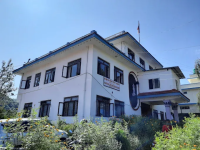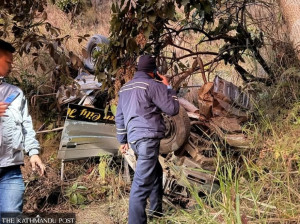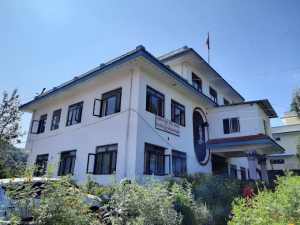Bagmati Province
Many of Nuwakot’s ancient heritages lie neglected and are slipping away from public knowledge
The ancient space of Mahamandal in Nuwakot also lies neglected.
Krishna Thapa
About half a dozen statues lie scattered at the northern front of the Jalapadevi Temple in Devighat, Nuwakot. The temple premises have been fenced with barbed wire, but the locals have cultivated vegetables in that space.
According to Mahendra Kumar Shahi, chief of Nuwakot Maula Amal, the site is an important place for Devighat Jatra. On a full moon day in the Nepali month of Chaitra, hundreds of devotees gather for Devighat Jatra and offer prayers in the temple.
“The legend has it that Devighat is the place where the Tibet king Songten Gampo married Nepali princess Bhrikuti. But today it lies in ruins.”
A statue in Jalapadevi was stolen five years ago.
In Khanigaun, which is near Devighat, there is a pauwa, a house made for religious ceremonies, where people from the local Magar community perform puja in honour of dhami, a priest. The pauwa today lies in a state of disrepair. The pauwa is owned by Bhairavi Guthi. After the earthquakes in 2015, the locals have encroached its space and constructed buildings. The ancient stone inscriptions are scattered around. Locals complain of the stakeholders’ indifference in conserving these heritages.
“Our field of jurisdiction is the Prithvi Narayan Memorial and those under the guthi only,” said Arjun Phuyal, chief of the Office of Memorial Conservation and Durbar Care.
The ancient space of Mahamandal in Nuwakot also lies neglected. The site where the unification of Nepal began is known by very few people these days. It is also the place where the third battle between the Gorkha Kingdom and Kantipur took place.
Today, the site is overgrown with weeds and grass. The temples of Batukbhairav and Kalabhairav temples are nearby, but little has been done to conserve them, said Shiva Malla, a local. “Mahamandal and its surroundings were important sites during the unification campaign, but they are in the shadows today,” Malla said.
“Here, in this very spot, our forefathers had fought against the soldiers of Prithvi Narayan Shah, but people have forgotten its history today.”
Deupakha Hill is another site in Nuwakot that carries historical significance. A few metres above the road that leads to the former headquarters of Nuwakot is a small flat space, surrounded by saal and chilaune trees, and here there is a large stone which the locals call ‘the royal stone’.
It is said that King Prithvi Narayan Shah used to sit on this stone during summer when the seven-storey temple would heat up.
Ishwar Khadka, a local of Bhutol, said: “The stone is where King Shah would sit and contemplate his war strategies, but it is so neglected today that it is covered with bushes.” Phuyal, the chief of the Office of Memorial Conservation and Durbar Care, said: “I have heard about the stone, but I haven’t been there yet.”
The Lichhavi-era pond, Panchalingeshwor Sitapokhari, is another important site that Nuwakot has failed to conserve.
Govinda Baniya, a local, said the pond, located west of the seven-storey durbar, is a sacred space where many perform Shradda—the annual rites carried out in memory of one’s deceased parents.
“Many believe that performing Shradda at this pond gives their deceased parents solace and in turn makes the family happy,” Baniya said. “Little has been done to preserve the pond.”
Towards the east of the old headquarters of Nuwakot is Saraswatithan. Construction of a gumba was commissioned here, but it hasn’t started yet. The site features relics of monuments dating back to the Licchavi era. Many of the temples and Buddhist monuments, constructed by King Amshuverma, are in shambles. One of the chaityas features inscriptions written by Prithvi Narayan Shah, but because of a lack of proper upkeep the inscriptions are being erased, said Anupraj Singh Khdka, a local.




 17.44°C Kathmandu
17.44°C Kathmandu












